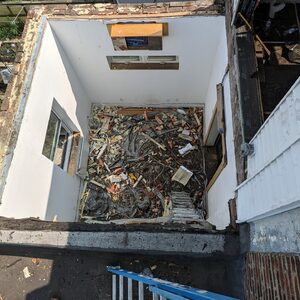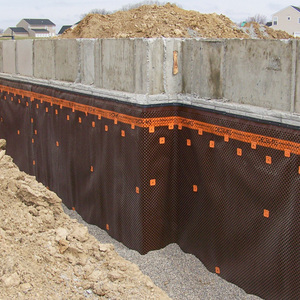was wondering what the prescribed method of building up beams is. just as an example:
lets say you need a 20 foot two member beam supported only at each end and can only get 16 foot or smaller lumber. i’m thinking you would want the splices a far away from the center as possible so would basically overlap the 16 footers and with 4 feet added to each end
is this the strongest way – would you glue and nail – through bolt – angled scarf joint, regular scarf, butt (if angled scarf which member would be lowest point).
thanks for all replys.



















Replies
You can't get LVL's? THey come in very long lengths, and are great beam material.
First off, you would need to determine the bending and shear at the location of the joint. (In this example, the 4 foot mark.) It would be necessary that whatever member size you select, it must be capable of sustaining the load (shear and bending moment) by itself at that point. BTW I would agree with your reasoning on this being the best location for the splice.
Assuming an adequate member size can be found (it might be LVL's depending on the loading) I would expect that bolted connection for the lap would be best. I would start with 2 or 3 bolts in a column, starting on each side of the joint. Whether or not the bolts in between the splice (over the 4 foot distance and the 16 foot distance) can be staggered or must be doubled or tripled, is going to be a function of the load in the beam.
For most wood members, I would expect a column of bolts at each side of each splice and then staggered bolts at 12 or 16 or 24" (depending on the calcs) over the distance between the joints.
I think bolts would be the best solution. Also keep in mind that the code (NDS) does not allow us to simply add the capacities of bolts and nails together as the mode of failure for each of the fastener types may be different. You may have some nails in place to assist fabrication but they are not additive with the bolts.
THis is an interesting question from teh standpoint of the bolts, forget the splices.
What is the purpose of teh bolts? If you have two members side by side, each will take half of the load, give or take. SO what does bolting the two members together gain you? Now I know this is the way it is done, so there must be a physics reason behind it. Perhaps it has more to do with the possibility of one member rolling, and if the two are bolted there is less likelihood of rool? Still seems like a minimal problem.
HMM?
You must keep in mind the original problem. There are two "beams" side by side but neither piece reaches the full span. As such, they must be fastened in some manner in order for the "omposite"beam to reach the full span.
SO what does bolting the two members together gain you?
By compressing the two members together, you decrease any risk of the members "shearing off" only those fibers actually bonded to the glue.
Ok, so that's the sort of thing only an engineer would consider, that the "join" between two hunks of lumber and some PL Premium might be stronger than the fibers of the lumber themselves. Which is likely moot, as those sorts of loads are likely well in excess of the bending or crushing moments of the beam in any event.
Where bolts likely are more needed is when a flitch of steel is introduced into the assembly. Sometimes, that steel is so strong, it only needs the lumber on either side to give a way to keep it from rolling, and to supply a nail-able surface. Not always, but soemtimes.Occupational hazard of my occupation not being around (sorry Bubba)
20 footers should be available but you won't find them in a big box.
Beat it to fit / Paint it to match
Beams can't be spliced inbetween posts unless they're DESIGNED to be spliced between the posts.
Actually, if you need to ask the very simple type questions, you need to do some homework before anybody would be comfortable giving you specifics (other than hireanengieer)<G>
Get a text such as Timeshenko and Youngs' "elements of strength of materials' from the library, a built up beam is fairly extensive set of calcs (not difficult, just a lot of items to remember)
The link is for a steel built up beam, but the calcs are the same as for wood, just differnet allowables.
http://www.ijee.dit.ie/OnlinePapers/Interactive/Philpot/spBuiltUp_13.swf
That is a really nice link Junkhound. Unfortunately, they use some language that will likely cause some confusion. In addition, the connection of the flange channels in the example, is not a good analogy for the beam splice question that was posted here. The calcs are NOT the same for the wood built up beam!
Very neat link though.
calcs are NOT the same ????????
Educate me, I dont want to mislead anybody on this board and will stand corrected if educated.
Always thought a truss is a truss is a truss or a beam is a beam is a beam whether steel or wood or putty, same with any structure. The numbers that go into the calcs are definetely different and connection methods are different, but the science and the CALCULATIONs are identical.
BTW, even for designing a, mechanical, hydraulic, or linear electrical circuit, the 3 basic differential equations are the same: Whether water or oil and valves and hoses; the front wheel, shocks and absorber on your car; or electrons with R, L and C - same exact set of differential equations.
Different properties and exponent values are DEFINETELY different in the results, but the calculations are the same. Pretty much the same with structure.
The link showed use of flange plates added to a steel beam. They would utilized to increase the bending capacity of the steel beam. They would not affect the shear capacity of the beam (I'm talking about the shear due to the vertical load).
In the example given on the link, the flange plate connection is designed to transfer "shear flow". I agree that the bolt capacity is (basically) the same calc with different allowables but the calculation of the shear that must be transferred would be calculated differently for flange plates compared to the LVL beam splice that was in the original post. In the steel beam example, all of the vertical shear is carried in the beam web. The shear flow that was part of the design example is from the need to transfer the bending forces to the extreme fibers of the beam, which would transfer flange force into the additional flange area that is contributed by the channels.
I have been told, generally speaking, that you do not want a splice in a built-up beam anywhere where you do not have an underlaying post support. This makes sense to me. I am sure a splice would be fine if the load were "light enough". DUH.
Ignoring all the side issues raised, you are correct that keeping the joints as close to the ends as possible would be the best approach, assuming a beam that is either center-loaded or uniformly loaded. If there are point loads near the ends then the answer could be different.
But it shouldn't be all that difficult to find 20-foot pieces, and that is indeed a far better approach.
A beam can't be spliced unless there's a column under the splice like basement girders. You said that you need a 20' beam to go end for end. That sounds to me that it's a 20' clear span and a specific size beam has to go the full 20' carrying a load above.
There's no splicing. Any lumberyard carries beams 20' and more.
"A beam can't be spliced unless there's a column under the splice like basement girders. "
Yes it can (as I stated in a previous reply) if the splice is located where the single piece can handle the stresses (shear and bending). This would most likely be the case with a LVL where the shear capacity is usually pretty good and where the splice is located close to the end bearing.
Most recently I designed an LVL beam with a splice located 24 inches from the face of their support. The contractor did not have the ability to carve out part of the old brick wall to allow a single piece to reach the full span and into the bearing pockets so a splice detail was needed. (trying to put a 20'-8" piece into a 20' wide span - the extra 8 inches was for the 4 inches of bearing on each end)
"You said that you need a 20' beam to go end for end. That sounds to me that it's a 20' clear span and a specific size beam has to go the full 20' carrying a load above."
Not necessarily.
"There's no splicing. Any lumberyard carries beams 20' and more."
Don't forget about the length of bearing required. I know you don't Joe but my point is that there are circumstances where a beam splice may be appropriate.
What happens if you need the full 20' of bearing to support a whole second floor above, are you saying that you can come up short with an 1-3/4" lvl at 16'and a 4' on one side and a 16' and 4' beam on the other side?This is what I'm talking about a 20' opening clear span holding up a second floor or maybe even a roof also. Are you saying that they can be spliced using 2 lvl's coming up short?Joe Carola
What I have been saying all along is that assuming the condition where one can not install a one piece beam that spans the full length of an opening (for whatever reason) it is necessary to analyze the shear and bending stress at the point at which one wishes to make a splice. On that basis, the proper splice joint can be designed.
For a simple case where the load is a uniform load over the entire length of a beam, the bending is maximum and the shear is zero at the mid span. Conversely, the shear is maximum and the bending is zero at the bearing end. Somewhere in between there, if one wishes to make a splice, one can analyze the stresses and select appropriate members and design a splice that works. I suggested that LVL's might be a good candidate as the shear capacity is generally high and the splice would naturally want to be located outside of the mid-span area.
I am not trying to say that getting full length pieces would not be better (where possible) or that long pieces are not available (I'v gotten 40 ft long LVL's before). I'm saying that in the case where a splice is needed it can (and must be) be designed and that such design is (usually) based on the shear and bending stresses at the location of the splice.
What happens if you need the full 20' of bearing to support a whole second floor above, are you saying that you can come up short with an 1-3/4" lvl at 16'and a 4' on one side and a 16' and 4' beam on the other side?This is what I'm talking about a 20' opening clear span holding up a second floor or maybe even a roof also. Are you saying that they can be spliced using 2 lvl's coming up short?So the answer to my questions above is yes?Joe Carola
My answer is: It depends on the loading and the member sizes that may be utilized.
Your suggestion that using 4 LVL's and offsetting the splice is no different from what I am saying except I am saying that in both cases, it is necessary to determine the bending and shear capacity of the splice.
I agree that there is a point of adding load that will exceed the member capacity of a single LVL, just as it is possible to exceed the capacity of doubles.
If we look at some specific numbers, a 20 foot span supporting about 1000 plf would need to incorporate 4 pieces (7" thickness) of 11 7/8" LVL as (I think) you described before. That would satisfy both shear and bending. I have not checked deflection though and I don't know what depth limitation there might be but if there is none, perhaps 2 pieces of 18" LVL could work lapped.
I'm saying that if you had a set of plans that were engineered and specked two 1-3/4" x 18" lvl's clear spanning 20'supporting x amount lbs and you couldn't get 20' lvl's. Are you saying that you can splice them??Joe Carola
You might be able to. Shear and bending stresses vary across the span so where bending is max, shear is least and vice versa.
It might help to say, there are many (perhaps most) cases that you are alluding to where the splice joint would not work but the more that deflection is controlling the beam selection, the more likely it will be that the splice joint can be made to work.
Edited 11/16/2006 3:55 pm ET by houseboy
Doesn't sound convincing to me. I've never seen a situation before so far that I can't put a beam in from one end to the next and having to cut it short and splicing it.I'll stick with full size beams from one end to the next unless I get a set of plans that say different. As far as I'm concerned right now, I would never trust it.Joe Carola
I would look for a different supplier who wouldn't be tellin me you can't get 20' LVLs. that must be the same guy who told my clients carpenter, they don't make 7"x14"PSLs.
Edited 11/17/2006 7:26 am ET by JoeArchitect
Joe,You posted to the wrong person because I never said that I can't get 20' lvl's. I can get any length I want. I can get 500'..........;-)Joe Carola
" I can get 500'..."
Order it and stick it outside your town. The town up the road from us has the world's longest hockey stick (a giant gluelam), but it can't be much over 200'...
Here's a shot of one that's 500' on my racks. I couldn't get the whole thing in the picture.Joe Carola
Joe that is quite a stiff one
500 feet long and no discernable deflection!!!
what was it for???
to cut up into window headers???"I believe that there is no God. I'm beyond atheism. Atheism is not believing in God. Not believing in God is easy -- you can't prove a negative, so there's no work to do. You can't prove that there isn't an elephant inside the trunk of my car. You sure? How about now? Maybe he was just hiding before. Check again. Did I mention that my personal heartfelt definition of the word "elephant" includes mystery, order, goodness, love and a spare tire?
So, anyone with a love for truth outside of herself has to start with no belief in God and then look for evidence of God. She needs to search for some objective evidence of a supernatural power. All the people I write e-mails to often are still stuck at this searching stage. The atheism part is easy.
But, this "This I Believe" thing seems to demand something more personal, some leap of faith that helps one see life's big picture, some rules to live by. So, I'm saying, "This I believe: I believe there is no God."
Having taken that step, it informs every moment of my life. I'm not greedy. I have love, blue skies, rainbows and Hallmark cards, and that has to be enough. It has to be enough, but it's everything in the world and everything in the world is plenty for me. It seems just rude to beg the invisible for more. Just the love of my family that raised me and the family I'm raising now is enough that I don't need heaven. I won the huge genetic lottery and I get joy every day.
Believing there's no God means I can't really be forgiven except by kindness and faulty memories. That's good; it makes me want to be more thoughtful. I have to try to treat people right the first time around.
Believing there's no God stops me from being solipsistic. I can read ideas from all different people from all different cultures. Without God, we can agree on reality, and I can keep learning where I'm wrong. We can all keep adjusting, so we can really communicate. I don't travel in circles where people say, "I have faith, I believe this in my heart and nothing you can say or do can shake my faith." That's just a long-winded religious way to say, "shut up," or another two words that the FCC likes less. But all obscenity is less insulting than, "How I was brought up and my imaginary friend means more to me than anything you can ever say or do." So, believing there is no God lets me be proven wrong and that's always fun. It means I'm learning something.
Believing there is no God means the suffering I've seen in my family, and indeed all the suffering in the world, isn't caused by an omniscient, omnipresent, omnipotent force that isn't bothered to help or is just testing us, but rather something we all may be able to help others with in the future. No God means the possibility of less suffering in the future.
Believing there is no God gives me more room for belief in family, people, love, truth, beauty, sex, Jell-O and all the other things I can prove and that make this life the best life I will ever have."
That's why you hire an engineer.
thanks...sure it is possible to find longer beam members..but i thought the question was interesting and the answer might be important some day.
thanks again
>> sure it is possible to find longer beam members..but i thought the question was interesting and the answer might be important some day. <<I think it would be interesting years and years ago if you couldn't get a specific size beam. If you wanted to span 20 and only had 16' available, then instead of just a beam made up of only two, you can make it up with four beams reversing the splicing gluing and bolting maybe.For today, they make beams any length so there would be no need to do what you asked for a clear span.Joe Carola
"was wondering what the prescribed method of building up beams is"
There is no prescribed method.
One needs an engineered method which requires an engineer.
Good answer.
Spheramid Enterprises Architectural Woodworks
I have irriatable Vowel syndrome.
LVLs and PSLs, both can be purchased to span the full lenght. No need to splice. Much metter than standard lumber for this situation. LVLs would be nailed or bolted together per manufacturer's requirements.
lets say you need a 20 foot two member beam
Then you need to splice 3 or 4 of em together so that no point has less than 2 effective members.
See an enginner for details.
Usually I don't shill for Home Depot but I bought 48' of LVL for a built up beam the other day, and after looking at how much plywood and glue went into the LVL it didn't seem that far off what I would have paid for the materials to make it myself. But like the others when I build up lumber beams I like to have no splices, or splices within the chord of a support post (? -I mean no farther from the post than the height of the beam. Is that the correct use of the word chord?) .